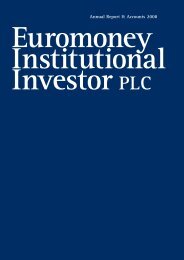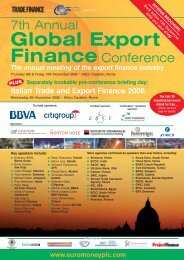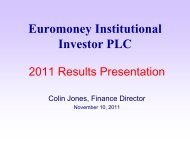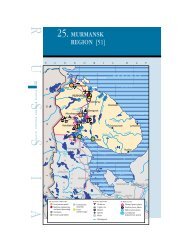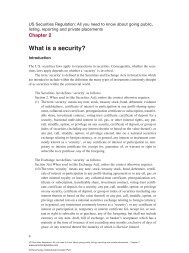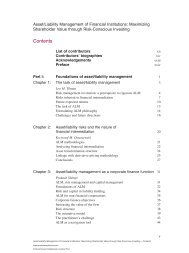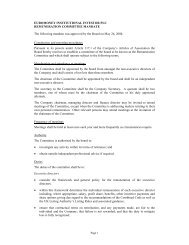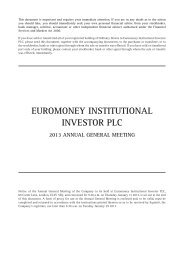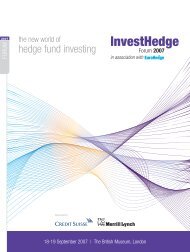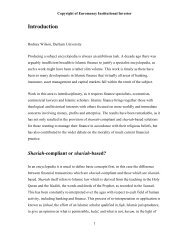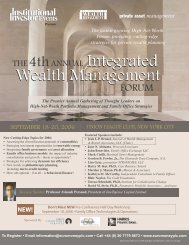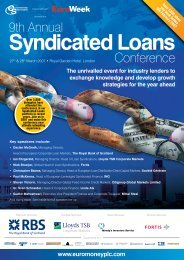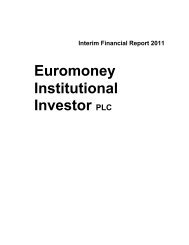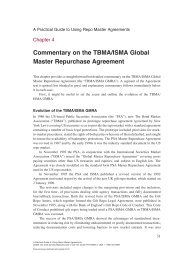something to smile about? - Euromoney Institutional Investor PLC
something to smile about? - Euromoney Institutional Investor PLC
something to smile about? - Euromoney Institutional Investor PLC
You also want an ePaper? Increase the reach of your titles
YUMPU automatically turns print PDFs into web optimized ePapers that Google loves.
MARKETFOCUSStrike whilehigh yield’s hot»Issue volume hit €16.6billion in 2003»Move from refinancingactivity <strong>to</strong> find M&AThe high yield market inEurope was the turnarounds<strong>to</strong>ry of 2003. New issuevolume hit a record high of€16.3 billion after amiserable two years. Whatcan issuers expect this year?Standard & Poor’s saysthat prospects of a cyclicalrecovery, a continuedaccommodative monetarypolicy stance, decliningdefault rates, and aslowdown in credit qualitydeterioration in theEuropean high yield marketwill mean that corporatesshould have strongconditions in which <strong>to</strong> issuein – though S&P also notesthat corporate downgradescontinue <strong>to</strong> be substantiallyhigher than upgrades.“Conditions remainfavourable in Europe,” saysDiane Vazza, managingdirec<strong>to</strong>r in global fixedincome research at S&P inNew York. “Monetary policyis really helping <strong>to</strong> keep itthat way.” StephaneTremelot, head of creditsyndicate at BNP Paribas inLondon, agrees that “slow[erthan expected] economicgrowth in the eurozone andthe dollar/euro exchangerate mean that it is unlikelythat the ECB will raise ratesin the short term. Thatmeans that there is anopportunity for issuers <strong>to</strong>benefit from issuing bondswith low yields.”Even if rates do rise, itdoesn’t necessarily spell anend <strong>to</strong> issuance, according<strong>to</strong> Nicholas Coates, head ofhigh yield at RBS in London.“Some issuers may makeopportunistic moves <strong>to</strong> dodeals before rate rises takeplace but issuers can alwaysuse the swap market <strong>to</strong> getcomparatively lowerfloating rates.”While spreads in the UShigh yield market havewidened by around 8bpsince the beginning of theyear, in Europe they havecontinued <strong>to</strong> tighten and arearound 38bp tighter than atthe end of 2002, according<strong>to</strong> Tremelot. Indeed, theaverage absolute yield forEuropean issues remainslower in Europe at 7.44%than in the US at 7.87%.Some market observersfear that Europe is <strong>about</strong> <strong>to</strong>succumb <strong>to</strong> the problemstroubling the US market,where fund flowsinformation provider AMGData Services has reportednet outflows from highyield funds in the US forthree of the four weeks <strong>to</strong>February 25. While theseoutflows are specific – andthus far isolated – <strong>to</strong> USfunds, their impact is morewidely felt: many of thosefunds also invest in theEuropean market; andtrends in the US high yieldmarket frequently pre-emptthose in Europe.Nevertheless, S&P’s Vazza– and most market observers– say that this is just ahiccup. “Inves<strong>to</strong>r demand isstill there but there has beena realisation that corporatespreads have tightened <strong>to</strong>ofast compared <strong>to</strong> creditquality and that there was aneed <strong>to</strong> set that right.”Coates adds: “Whilst theEuropean high yield markethas softened over the pastmonth, we believe this <strong>to</strong> bea temporary phenomenon: acorrection <strong>to</strong> a bullishmarket. The long-term trendis for increased liquidity inEurope and demand willremain strong as fundscontinue <strong>to</strong> flow in<strong>to</strong> themarket.” More bullishcommenta<strong>to</strong>rs say that thesoftening of the market hasresulted from inves<strong>to</strong>rsselling bonds in order <strong>to</strong>have cash <strong>to</strong> respond <strong>to</strong> theexpected deluge of newissuance expected.Either way, no-oneexpects the high yieldmarkets in Europe <strong>to</strong>flounder this year. IssuanceYTD has been limited –around €2 billion from 10deals compared <strong>to</strong> $25billion from around 100deals in the US – but BNPParibas’ Tremelot says thatthis is common for thisperiod of the year. “Unlikethe high grade world Januaryand February are quietmonths as issuers and banksprepare new transactions.”While it is impossible <strong>to</strong>know if we are at thebot<strong>to</strong>m of the credit cycle,all the indica<strong>to</strong>rs show thatthe economy is improving,credit quality is improving,and inves<strong>to</strong>r demand isn’t<strong>about</strong> <strong>to</strong> collapse.And while all thesefac<strong>to</strong>rs may be pullingissuers <strong>to</strong> the high yieldmarket, the long-termstructural trend of reducedbank lending – not leastbecause of Basel II – is alsopushing issuers <strong>to</strong>ward it.“European corporatesincreasingly view thehigh yield product as amainstream financing<strong>to</strong>ol.”Nicholas Coates, RBS“Banks have become muchmore focused on the riskadjusted returns of theircredit provision and areoften less resistant than theyhave been in the past <strong>to</strong>corporates diversifying theirsources of funding awayfrom the bank market,” saysRBS’s Coates. “That is asignificant change.”Who’s issuing?The high yield market hastraditionally been driven bythree sources of issuance –leveraged buyouts (LBO),telecom, media andtechnology (TMT) andgeneral corporate issuance.“For the first time thesethree components of theprimary high yield marketin Europe will produce dealssimultaneously this year.That means that we canexpect a strong level ofissuance,” says Coates.LBO issuance is expected<strong>to</strong> provide a quarter of themarket in 2004 while TMTissuance should match lastyear issuance of almost €6billion. But the key <strong>to</strong> thepotential market growth iscorporate issuance.One of the main reasonsfor the growth of theEuropean high yield marketin 2003 was issuance fromfallen angels – issuers thathave fallen <strong>to</strong> speculative(rated BB+ and below by S&Pand Ba1 by Moody’s) frominvestment grade (BBB- andabove by S&P and Baa3 byMoody’s). Of the <strong>to</strong>tal €16.3billion raised in Europe,fallen angels accounted for6 cf March 2004 corporatefinancemag.com



